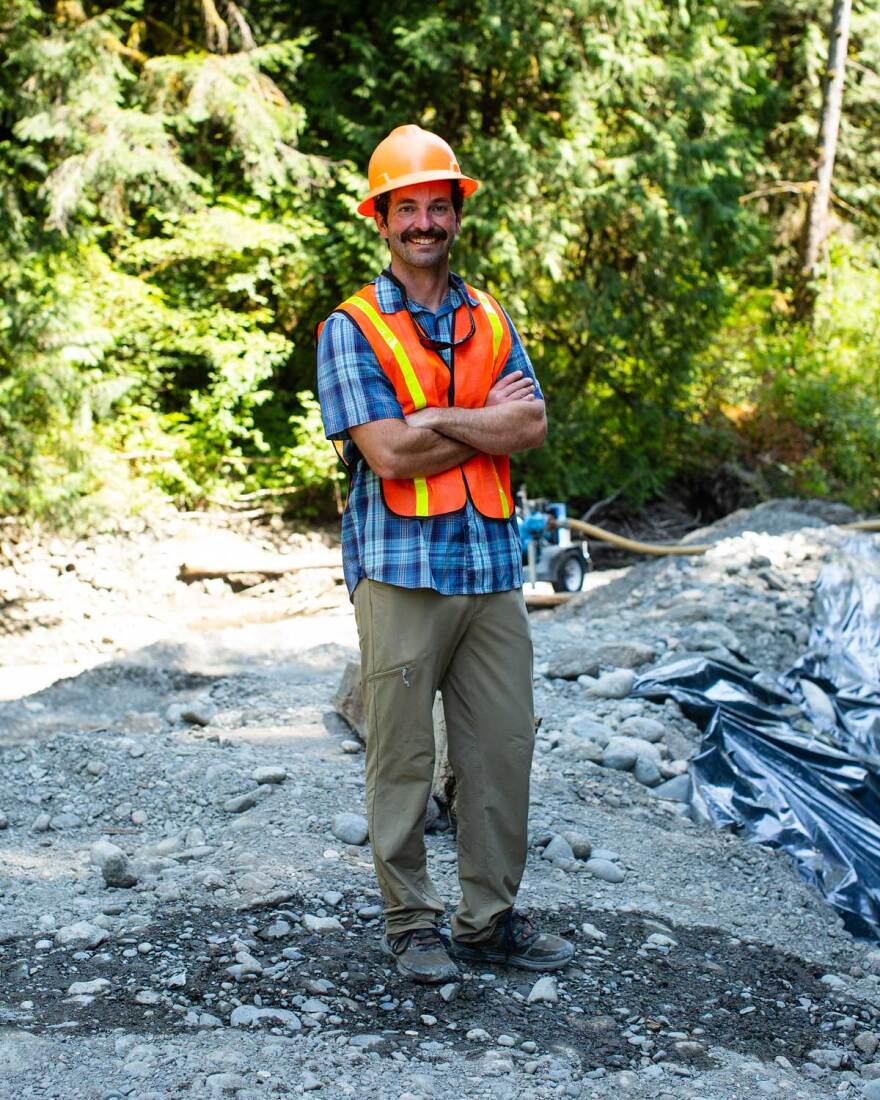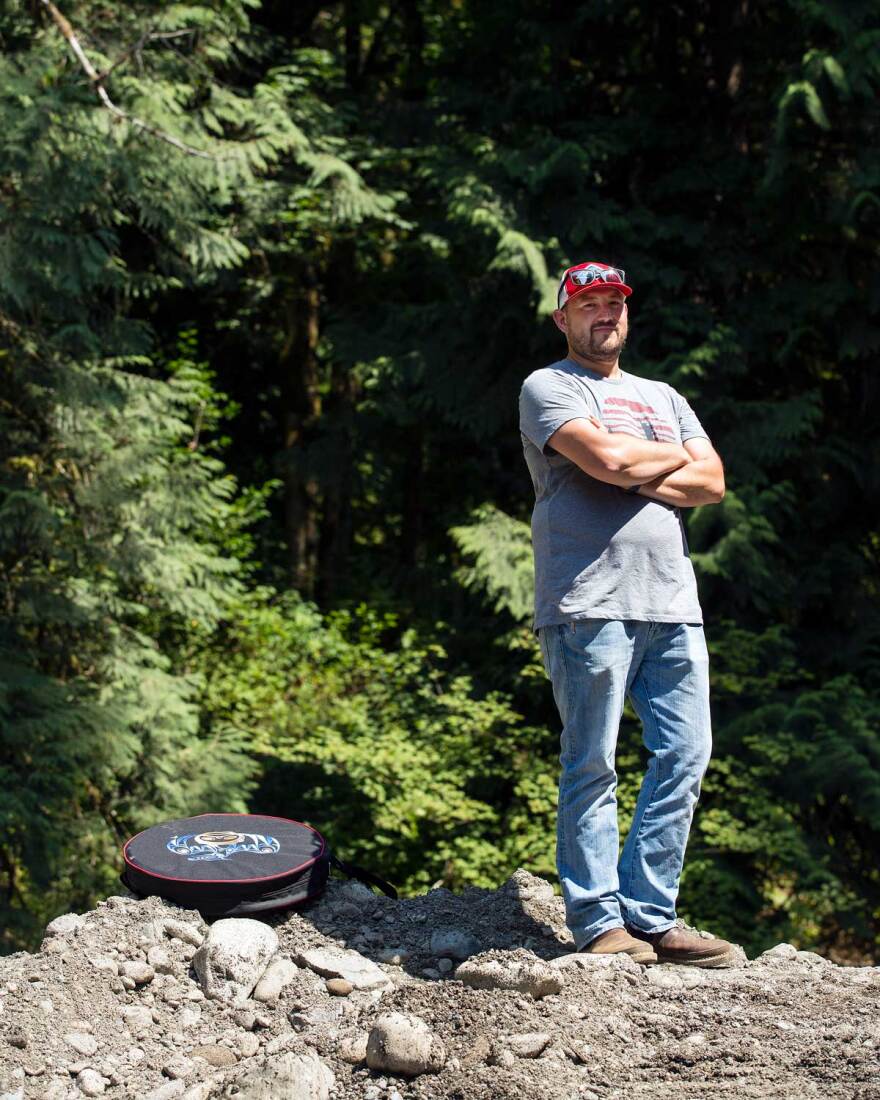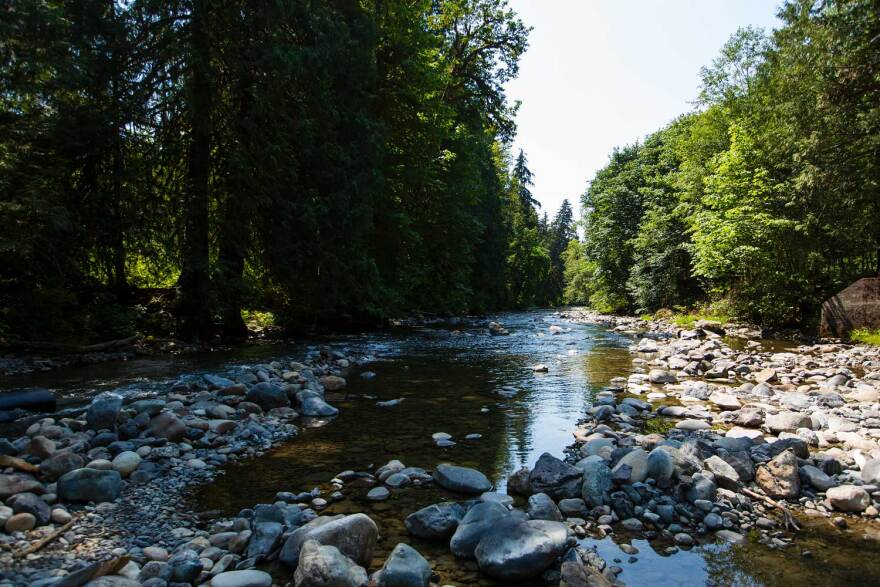This week, the Pilchuck River will be redirected to its original channel, after the removal of two dam structures that have held it back for more than 100 years. It’s a relatively small project, compared to the monumental dam removals on the Elwha River in 2014 or even this summer’s explosive demolition work on the Nooksack.
But taking down this 10-by-60-foot barrier promises to dramatically improve critical habitat for salmon and steelhead.
The dam is located near Granite Falls, about 15 miles upriver from the City of Snohomish, which built it in 1912 to boost the water supply after a huge fire nearly leveled the town.
Three years ago, the city stopped using it. Officials say it required repairs and maintenance that had become uneconomical. They partnered with the Tulalip Tribes on the demolition and restoration work.
At the dam site now, the river runs between steep forested bluffs that tower overhead. Berms and tarps and hoses manage the water, as two big yellow excavators chomp at concrete.
Brett Shattuck, restoration ecologist for the Tulalip Tribes, says the work is progressing swiftly.

“So we're hammering away. We're scooping up the old concrete and we're getting really excited to get the river put back in its natural condition,” he said.
Come winter, this river will run high and fast enough to reach the top of the bluffs above where we’re standing, about two stories overhead. The water here fluctuates dramatically.
“That's the cool thing about these rivers: they’re wild. They like to move. They like to change seasonally. They like to change temporally,” Shattuck said. “So we're trying to re-initiate that sense of wildness in this river, to connect it upstream and downstream, so we can get fish passage all along this river. And especially to the upstream habitat that's in the best condition.”
The dams here were initially built without a fish ladder. One was added later, but it didn’t work well. Coho salmon could be seen every fall, smashing up against the dam wall; many would die from their injuries before they could spawn. Chinook returns dropped as low as just 50 fish in recent years, on a run that’s estimated to have a historical capacity of 15,000.

But Shattuck says above the dam is 37 miles of excellent habitat — mostly working forests and public lands.
“Much cooler water temperatures, much more complex habitat. Everything that these salmon need to really survive and to thrive in terms of spawning and rearing,” he said.
Just a few paces upstream, Ryan Miller is already scanning the gravelly river bottom, dreaming of a future with more fish — one that should come as soon as this fall, when the demolition work is complete. He’s envisioning where the salmon will lay their eggs.
“Right at the top of this tail out right here, you'll see there'll be two or three reds right there,” he said, pointing at the small rock piles beneath the clear cool water. “I mean, I could just see it from my years of surveying stuff and knowing the habitat. They'll be right there. It's perfect.”
As a younger man, Miller did fish surveys for the tribe. Now he’s a program manager with the Tulalip’s Treaty Rights Office. His family has deep ties to this river.

“My great-great-grandmother Sarah was born in this area. Her family is the dxwkwi??babš band of the Snohomish. And their territory was the Pilchuck drainage,” Miller said.
They had several village sites in the area and would travel between them by canoe, partly on the Pilchuck. He remembers learning that history and feeling a deep connection when he would come out to work on this river.
“I would get to flow past the place where, you know, your family's village was there a hundred years ago," he said. "And that's really special.”
Seeing the dam come down fills Miller with gratitude. For him, it’s definitely about the fish. But, he says his people have been in this area for at least 14,000 years, beginning soon after the Vashon Glacier receded.
“So, for 14,000 years, they traveled this waterway. And then one day there's a concrete wall here,” he said.
“And it's the same for the fish. For how many hundreds of generations that they travel up here to lay their eggs and their progeny travel down out of the river and into the ocean and then came back — repeating that cycle over and over and over. And then one day there's a dam here. And those are the kinds of things that we know we can do something about and we need to.”
Before leaving the river, he unpacks a drum he brought and uses it to call to his ancestors with a song he says is about a barren auntie, who sings about how hard she works, constantly.
“She's saying, you know, all day and all night I work all day and all night,” he says.
"The moral of the story really is that you have to work hard all the time to make sure that you have enough food to feed yourself and your family through the winter. I've always liked it. And I think it's good for a situation like this one,” he says, as the engineers continue to move dirt and hoses and take measurements all around the dam site.

His song is meant as a kind of blessing, to let those who went before him know that their culture is still here.
“When we stand up, when we drum, you know, our ancestors hear us," he said. "And they come and they look to see what's happening and make sure that we're doing it with good hearts.”
This project is an important new partnership with the City of Snohomish. And it will contribute to efforts to restore Puget Sound salmon that are badly needed for the endangered Southern Resident orcas, whose numbers are dwindling. Miller says it’s equally important to Coast Salish tribes, whose cultures depend on abundant fish.
So the dam removal, which will be more formally celebrated when it’s complete this fall, is a significant accomplishment. But there’s still a lot of work to do. And much of it will be harder than this project, especially on the habitat downriver of the dam site, which is flanked by development and farmland.








